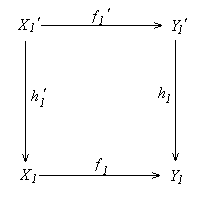|
In this section we assume C is a metric site with finite limits (i.e., C has fibre products and a finite object). Definition 5.2.1. We say a morphism f: X d Y is universally open (resp. closed, resp. bicontinuous, resp. surjective, resp. injective, resp. effective, etc) if, for any base extension Y' ® Y, the morphism fY': XY' ® Y' is open (resp. closed, resp. bicontinuous, resp. surjective, resp. injective, resp. effective, etc). Remark 5.2.2. More generally, if a morphism f: X ® Y has certain property P, and if for any base extension Y' ® Y the morphism fY': XY' ® Y' also has the property P, then we say that f has the property P universally. We say the property P is stable under base extension if for any morphism f having the property P, f has P universally (in which case we also say that the property P is an absolute property). Example 5.2.3. The following
properties for a morphism f: X ®
Y in a site C are absolute:
Example 5.2.4. Suppose C is a
site such that t: C ®
Top preserves finite limits. Then the following properties for a
morphism f: X ® Y are
absolute:
Proposition 5.2.5. Suppose a monomorphism f: X ® Y is universally closed (resp. open), then f is universally bicontinuous. Proof. Since f is a monomorphism, for any base extension g: Y' ® Y, fY': X ×Y Y' ® Y' is a monomorphism, therefore fY' is injective (1.3.6). But fY' is closed (resp. open), therefore fY' is bicontinuous. Proposition 5.2.6. Suppose f: X ® Y is a universally bicontinuous morphism. Then f is universally closed (resp. open, resp. homeomorphism) if and only if f(X) is closed (resp. open, resp. the whole set X) Proof. Since by assumption f is universally bicontinuous, for any base extension g: Y' ® Y, the morphism fY': XY' ® Y' is closed (resp. open, resp. homeomorphism) if and only if the image |fY'(XY')| = g-1(|f(X)|) is closed (resp. open, resp. surjective) (1.3.8), i.e. if and only if |f(X)| in X is closed (resp. open, resp. the whole set X). The following three propositions (5.2.7) - (5.2.9) hold for universally open, universally closed, universally bicontinuous, universally injective and universally homeomorphic morphisms. For simplicity we only treat the case of universally closed morphisms. Proposition 5.2.7. (a) The
composition of two universally closed morphisms is universally closed.
Proof. (a) and (c) follows directly from the definitions and
(4.2.6.d). (b) follows from (a) and (c)
by (5.1.11).
Proposition 5.2.8. Suppose
f: X ® S is a morphism. The following
conditions are equivalent:
Proof. First we assume (a) holds. Using the notation of (5.1.5)
we have p = (DX)T.
Since by assumption DX: X
® W is universally closed, p
is universally closed by (5.2.7.c). Thus (a) implies
(b).
Proposition 5.2.9. The following
assertions for a site C are equivalent:
Proof. By (5.2.8). Proposition 5.2.10. (a) Suppose
in C any spacial morphism is universally bicontinuous. If
f: X ® Y and g: Y ®
Z are morphisms and gf is universally bicontinuous, then so is f.
Proof. These assertions follow from (5.1.12) and (5.1.13). Proposition 5.2.11. Suppose f: X ® Y and h: Y' ® Y are two morphisms in a site C. If h is surjective and fY': X ×Y Y' ® Y' is universally injective. Then f is universally injective. Proof. Consider a base extension Y1 ® Y, f1 = fY1. Let Y1' = Y1 ×Y Y', X1' = X' ×Y' Y1' = X1 ×Y1 Y1', f1': X1' ® Y1'. Consider the diagram  Proposition 5.2.12. Suppose C is a site with fibre products. Then the regular monomorphisms in C are universally bicontinuous if and only if the topology t: C ® Top preserves the fibre products of the form f ×X g where f: U ® X is a section and g: Y ® X is any morphism. Proof. In any site a section f: U ® X is bicontinuous. Since C is separable, the projection p: U ×X Y ® Y is injective with the image g-1(U). Thus the regular monomorphism p is bicontinuous if and only if t preserves the fibre products of this type.
|